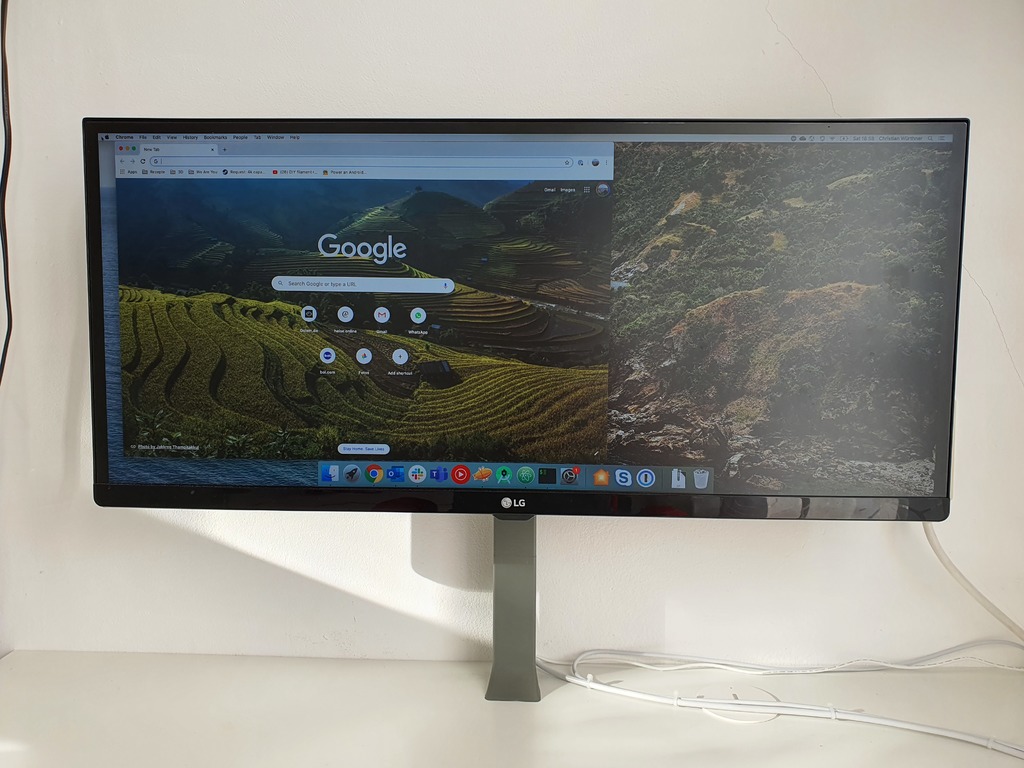
Modular & Height Adjustable VESA Stand
prusaprinters
<p>Please read carefully before building the stand! All pictures shown are v1, I did not print and build the current v2 but all adjustments where tested virtually.</p> <h3>About the Stand</h3> <p>I moved my VESA display stand to my Living room and needed a new height adjustable one for the office. This design costs around 10€ to make including material, energy and filament. The design is modular, so you can adjust it to your needs.</p> <p>The core of the stand is a M8 rod (v1 used M5, shown in the pictures). All elements are "threaded" onto the rod. This means that the parts itself do not need to have high infill or wall thickness. I printed mine with 10% and 2mm walls (4 lines with 0.5mm nozzle) and I'm confident I could hang way more than a display on this stand. The newer M8 rod versions are even stronger.</p> <p>At the moment the stand is attached to the desk by drilling two holes and using nuts to fix the rod directly to the desk. It's possible for me to design a clamp if anyone needs one.</p> <h3>Preparation</h3> <p>Below information is for the latest version. Please see at the end of the document for changes from previous versions.</p> <p>The design has following parts:</p> <p><strong>A1</strong>: Top cap <strong>A2</strong>: Top <strong>B1</strong>: Pillar with mounts <strong>B2</strong>: Plain pillar <strong>C1</strong>: Desk mount top <strong>C2</strong>: Desk mount bottom <strong>D</strong>: Cable clips <strong>E</strong>: Vesa mount</p> <p>1x A1 + A2</p> <p>?x B1</p> <p>?x B2</p> <p>1x C1 + C2</p> <p>?x D</p> <p>1x E</p> <p>1x M8 rod (you'll get them for next to nothing in your local department store, usually 1m for around 2€)</p> <p>4x M8 washer, max ø22mm</p> <p>5x M8 nut</p> <p>1x Power drill (or something else to drill two holes in the desk)</p> <p>1x Metal saw (or something else to cut the rod, I used a multi tool)</p> <p>1x Marker</p> <p>2x Pliers (or a wrench and a plier or two wrenches to tighten two nuts at the same time)</p> <p>The number of B1 and B2 parts depends on how tall you want the stand to be. Please keep in mind that higher stands will tend to bend more although this should not be an issue with displays < 30" and reasonable high stands. I'm using a ~5kg heavy 29" screen with the old M5 version and have no stability issues with 2x B1 and 2x B2. Again, the M8 version is much stronger.</p> <p>The VESA mount supports both 75x75 and 100x100 standards. It's a good idea to use a little more infill/wall thickness on this part but it should not be a problem. I use the same 10% infill and 2mm walls here.</p> <p>The mount is unfortunately a little tricky as all displays are slightly different. The tooth system I choose for easy height adjustment may lead to some displays leaning forward. That's why I added the little arm with a spacer in the middle to prevent the screen from leaning. Some displays might have some ports directly under the VESA mount. The arm will block those ports. On my LG, the HDMI ports are also super close to the mount and they barely fit.</p> <p>My advice: Print the VESA mount first (it's only ~30g) and try to mount it on your screen.</p> <h3>Instructions</h3> <p>The pictures are showing version 1 of the stand, your parts might slightly differ.</p> <p>As mentioned above, print and test fit the VESA mount (part E). Make sure all required ports are accessible. If you need some adjustments, write a comment :)</p> <p>Print all required parts for your setup</p> <p>Measure the desk thickness</p> <p>Cut a piece of the rod with the thickness of the desk. Add an extra 3cm to the thickness of the desk.</p> <p>Place part C2 on top of the desk and drill the two holes into the desk. Make sure both holes are drilled straight down for optimal fit later.</p> <p>Place nut in the pocket of C1 and insert the short part of the rod threading it into the nut</p> <p>Place a nut on the rod, leave desk thickness + 3cm between the nut and the end of the rod. Put a washer on the rod (on the long side of the of the rod, not the 3cm). I left some extra in case I want to make the stand higher in the future.</p> <p>Put C1 on top of the washer</p> <p>Put all B1 and B2 on top of C1</p> <p>Put A2 in top of the other parts</p> <p>Mark on the rod where A2 ends (optional, remove parts from rod) and cut the rod with the saw</p> <p>Place all parts back on the rod</p> <p>Put a washer and above A2 and tighten loosely. With the two pliers (or the wrench) tighten the nuts on both ends of the rod as tightly as possible. As always: There is too tight but also too loose. Don't over do it.</p> <p>Put the assembly on the desk guiding the two rods through the holes</p> <p>Put A1 on A2</p> <p>Put C2 on the rods from below the desk and put two washers followed by two nuts on the rods and tighten</p> <p>Mount the VESA mount on your display</p> <p>Hang the display on the stand</p> <p>Connect all cables and put the cable clips in place</p> <h3>Versions</h3> <p><strong>v2</strong></p> <ul> <li>Replaced M5 rod with stronger M8, outer shape adjusted for new rod</li> <li>Added nut trap for C1</li> <li>Fixed holes in C1 and C2 for short rod have no clearance applied</li> </ul> <p><strong>v1</strong></p> <ul> <li>Initial version</li> </ul> Category: Office
With this file you will be able to print Modular & Height Adjustable VESA Stand with your 3D printer. Click on the button and save the file on your computer to work, edit or customize your design. You can also find more 3D designs for printers on Modular & Height Adjustable VESA Stand.
